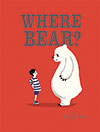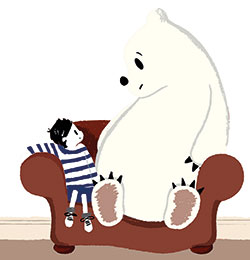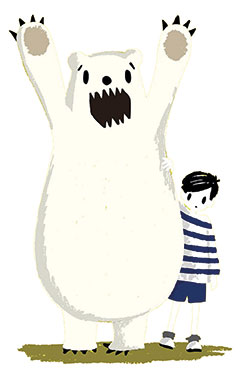
Download the PDF of this article
This simple but beautifully illustrated picture book is about a boy and a bear. The bear has lived with the boy since he was a cub, but he is now fully grown. The boy, whose name we never find out, seeks to find a new home for the bear. As we turn the pages, we see the bear try out a variety of different homes that the boy suggests. These include a toy shop, the circus, the zoo, the woods, even the jungle. Each time, the bear says ‘no’ and the illustrations leave us in no doubt as to why the bear cannot settle there.
Finally, the boy finds the solution, and they head off to the Arctic. The bear has found a home at last, and we see that both the bear and the boy are happy. The story ends with bear and boy deciding they should go somewhere together – but, of course, they can’t work out where!
A GOOD CHOICE
 This is one of those books that can be enjoyed by a variety of age ranges. Its simple language will make it suitable for toddlers, and it is worth noting that a board book edition is available.
This is one of those books that can be enjoyed by a variety of age ranges. Its simple language will make it suitable for toddlers, and it is worth noting that a board book edition is available.
For three- and four-year-olds, the simplicity and repetition of the language alongside the illustrations will allow them to access the book independently once it has been shared with them a few times. It is also good to use with early readers, as being able to read and understand a book with minimum adult input will boost their confidence.
SHARING THIS BOOK
Here are some themes to explore along with follow-up activities.
Personal, social and emotional development
 There are plenty of elements within PSED to explore in this book with older children. First, using the illustrations, you could see if children can infer emotions from the illustrations. What is bear feeling when he is in the zoo, or what is bear thinking when he sees a tiger in the jungle?
There are plenty of elements within PSED to explore in this book with older children. First, using the illustrations, you could see if children can infer emotions from the illustrations. What is bear feeling when he is in the zoo, or what is bear thinking when he sees a tiger in the jungle?
You could also encourage children to think about what it means to be a good friend. This could lead to conversations about being kind and also trying to think about the needs of others. In the story, the boy knows that the bear needs a new home and works hard to help the bear find it.
Another element within the story is the concept of ‘home’. This could lead to interesting discussions about how it feels to be at home and how everyone’s home is different.
While these conversations may be valuable, we need to be sensitive in our approach for those children whose home lives are difficult, and equally we may need to pick up on anything that is said which may raise safeguarding concerns.
Language development
This is a great book to encourage children to develop their narration skills. While the text outlines the story, you could model language based on the illustrations for younger children – for example, ‘When the bear walked into the cave, he was suddenly terrified.’ Older children may be able to recall the story and add in other conversations, including why bear does not like the various homes suggested.
 This is also a book that raises many questions, and children may come up with some imaginative replies. For example, where did the bear come from originally? The boy and the bear aren’t given any names, but what do the children think they might be called? Did the boy have to ask the owner of the toy shop or the zookeeper before the bear tried it out? How did the boy and the bear get to the Arctic?
This is also a book that raises many questions, and children may come up with some imaginative replies. For example, where did the bear come from originally? The boy and the bear aren’t given any names, but what do the children think they might be called? Did the boy have to ask the owner of the toy shop or the zookeeper before the bear tried it out? How did the boy and the bear get to the Arctic?
There are also opportunities to draw children’s attention to some mathematical language. In the early pages, we see how bear grows in comparison to the boy. There is one illustration where we can point out that bear is small, then medium-sized before becoming large. Using cuddly toys or objects that appeal to children, these could also be grouped into small, medium and large.
Expressive arts and design
The theme of home can be drawn upon so that children can make their own dens or create a home for bear and the boy. You could look for a variety of lengths of fabric so that, at its simplest, children can drape it over tables to create a den indoors or outdoors.
You may also consider looking out for other materials that the children could use to create structures, such as crates, cardboard boxes and wooden frames. Children may also wish to decorate and furnish their homes, and this can lead on to role-play opportunities.
Understanding the world
One of the major themes in the book is where bear should try to make a new home. This could lead to an interesting exploration of different types of home where people live – for example, a flat, house, caravan and even boats. You could also widen the theme to include animal homes that may be unfamiliar to the children – for example, a badger’s sett and rabbits’ burrows.
- Look out for websites such as the Royal Society for the Protection of Birds (RSPB) that have sections on wildlife, https://bit.ly/2P3lU85
ABOUT THIS SERIES
Over the course of this monthly series on sharing books with children, Penny Tassoni will look at a range of fiction and non-fiction titles, from rhyming books for babies to picture books that adults and children can explore together.









